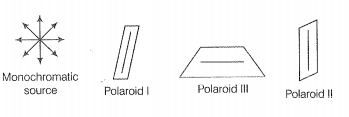A polaroid (I) is placed in front of a monochromatic source. Another polaroid (II) is placed in front of this polaroid (I) and rotated till no light passes. A third polaroid (III) is now placed in between (I) and (II). In this case, will light emerges from (II)? Explain.
Hint: The polarization of light depends on the angle between the polaroids.
Step 1: Find the angle between the (I) and (II) polaroid.
In the diagram shown, monochromatic light is placed in front of polaroid (I) as shown below.

As per the given question, monochromatic light emerging from polaroid (I) is plane polarised. When polaroid (ll) is placed in front of this polaroid (l) and rotated till no light passes through polaroid (ll), then (l) and (ll) are set in crossed positions, i.e., pass axes of l and ll are at 90.
Step 2: Find if the light emerges from the polaroid (III).

Consider the above diagram where a third polaroid (III) is placed between polaroid (l) and polaroid ll. When a third polaroid (lll) is placed in between (l) and (ll), no light will emerge from (ll), if the pass axis of (lll) is parallel to the pass axis of (l) or (ll). In all other cases, the light will emerge from (ll), as the pass axis of (ll) will no longer be at 90° to the pass axis of (lll).

© 2025 GoodEd Technologies Pvt. Ltd.